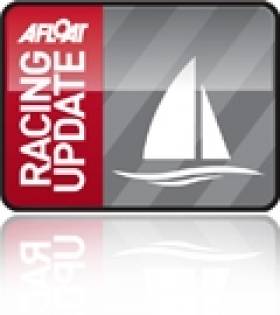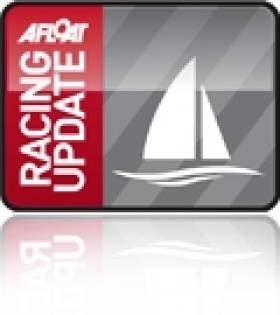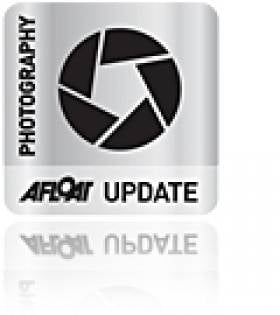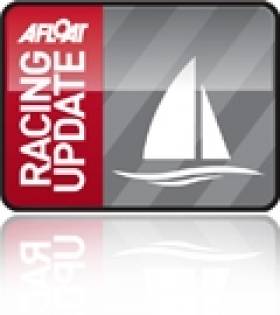Displaying items by tag: Royal St. George
Sun Shines on Dun Laoghaire Squibs
More than 70 boats and 400 sailors, their families and friends from Ireland and the UK converged on Dun Laoghaire this weekend for the start of the biggest event in the sailing calendar in Dublin Bay this year. All the photos (by Gareth Craig) from Race one of the Squib National Championships are here.
Goodbody Retains Sigma 33 Title on Dublin Bay
In spite of a slip in a double points race Tim Goodbody of the Royal Irish YC has retained his Irish Sigma 33 title after a ten race series on Dublin Bay at the weekend. The three day regatta attracted a fleet of 14 boats from six clubs. Second overall was Kinsale's Clem McElligott in Seahawk. Third was Rupert, Paddy Varian and Dick Lovegroves' entry from the Royal St. George host club. Overall prizes of plaques bearing half models of the Sigma 33 were well received.
Irish Company to Install New Pontoons in Dun Laoghaire
The prestigious club, which was founded in 1838, is hosting the week-long SF Marina IRL Squibs National Sailing Championships from June 18th. Over 100 boats and 600 sailors from Ireland and the UK will descend on Dun Laoghaire for the event, providing a welcome boost to the local economy.
Today Kilkenny based company, SF MARINA IRL, who build floating concrete pontoons and breakwaters for marinas, will embark on the task of putting into place 4 permanent pontoons weighing 252 tons each and measuring 5 metres wide and 80 metres in length.
The pontoons were manufactured in Sweden and shipped by coaster to Ireland. They were offloaded by crane at Dublin Port last week and were floated across Dublin Bay to Dun Laoghaire for installation today. A team of experienced riggers from Bere Island in Cork who have worked closely with SF Marina Irl for the past 12 years will be anchoring the pontoons today. Because of the difficult wave conditions in Dunlaoghaire the pontoons will be anchored with 30 tonnes of heavy steel chain and twenty four five tonne anchor blocks buried in the mud in the sea bed.
The pontoons have a core of styrofoam encased in high quality reinforced concrete. They are designed to endure storms, floods and hurricanes and are unsinkable.
SF Marina Irl, sponsors of this year National Squib Championships - are the only company of its type in Ireland, and has built marinas and installed floating pontoons and breakwaters all over the country, north and south, as well as the UK. The directors are Rod and Julie Calder-Potts who trade under Milford Marina Systems and are based in Cuffesgrange, Co Kilkenny.

Recently the company designed and fitted concrete pontoons weighing 1,000 tonnes on the River Liffey to service the Waterbuses Spirit of Docklands and Liffey Voyage . The project consisted of a megayacht visitors berthing facility on the Custom House Quay and three waterbus landing stages - one at The Point, one south-east of The Ha’Penny bridge and one at the mouth of George’s Dock on Custom House Quay.
The pontoons have been praised for the fact they merge perfectly with the backdrop of the cityscape.
Other projects have included breakwaters in Garrykennedy, Cahirciveen, Lough Allen, Lough Erne, Inisturk beg, Dinish Island, the lower Ban River and Stangford Lough, to name but a few. SF Marina Irl are also involved in project management of marina installation in the UAE using Irish expertise and personnel.
SF Marina Irl is the sole Irish agent for Swedish company SF MARINA Sweden specializing in the supply and installation of floating concrete breakwaters that can stand up to the rigorous maritime conditions.
Rod Calder Potts of SF Marina Irl said today: “We are very proud to be associated with the Historic Royal Saint George Yacht club and with the Squibs national Championships. This is our third major installation in Dunlaoghaire Harbour and the eighth in the Dublin Bay area. We enjoy the challenge of dealing with the difficult Irish tides, winds and waves. It is a pleasure and a privilege dealing with the wonderful sailing clubs around Dublin Bay. “
The annual National Squib Championship, with competitors from all over Britain and Ireland, is held in Ireland every Fifth year, and this years event will be the biggest sailing event on the 2010 calendar in Dublin Bay.
The Squib Class fleet is one of the largest one-design fleets in Britain and Ireland, with over 810 boats. The National Squib Owners Association (NSOA) has 640 members from all over the UK and Ireland. Squib Sailors at the Championships will range in ages from mid 20s to 60s.
Squibs- which are two-man keelboats measuring 7 metres long - are also owned in many other parts of the world and are favoured both as an exciting racing boat and, because of their strength and safe design, as a teaching boat.
A National Championship has been held for the Squib Class every year since 1972. Every fifth year it is held in Ireland, where the Class is expanding and is this year attracting interest from a wide range of clubs from Royal North of Ireland YC to Kinsale YC. There are particularly strong fleets in Dun Laoghaire and Howth.
With such superb facilities, both on and off the water, the Royal St George Yacht Club says it is confident that the SF Marina Irl. Squib National Championships will be a most memorable event.
The club has a long history and tradition in Irish Sailing and is Ireland’s current Sailing Club of the Year, reflecting its magnificent waterside setting, attractive Clubhouse and full range of sailing, social and race activities.
Two RSGYC teams in Wilson last eight
Two teams from the Royal St., George YC in Dun Laoghaire made it to the last eight of the 339-race Wilson trophy after 20 rounds of competition at West Kirby Sailing Club this weekend. It is the 16th appearance for the club at the UK event. Both the George Knights, (John Sheehy/Noeline Morgan, Nick Smyth/Rach Macmanus and Ger Owens/Melanie Morris) and another Royal St George team (Marty O'Leary/Brian Fenlon, Sam/Rachel O'Brien and Jonny O'Dowd/Rachel Guy) reached the quarter-final stage and pushed their quarters to the third race of the best-of-three, but failed to progress.
The final day of the 2010 Wilson Trophy dawned beautifully bright and clear and following a brief delay to allow the wind to build strength and stabilise direction, racing for the final part of the round robin element got underway. At this stage in the competition, every point counted for those teams hoping to make into the final eight and with a gaggle of teams mathematically capable of progressing to the next round, many of the matches understandably developed into full pitched battles.
American visitors Team Extreme continued where they had left off from the previous two days and immediately began adding to their string of winning performances to further extended their advantage at the top of the leaderboard. By midday the both local West Kirby Hawks and the American Woonsocket Rockets had also guaranteed their places in the quarterfinals. Despite showing much promise in the previous two days, the team from Royal Thames suffered a disastrous sequence of defeats in the early morning races, which plummeted them down the pecking order and effectively snuffed out their chances of qualifying for the knockout rounds. Meanwhile both Bath and the local Hibre Highlanders team were staging last-ditch bids to make the final eight with stellar performances in their races. When these two teams eventually met, it was the Hilbre Highlanders who managed the last beat to perfection to cross the line in a convincing 1,2,4 configuration and keep their hopes of a quarter-final berth alive.
The final round of races threw up a series of do or die confrontations. In the match between the Royal St George and New York Red the American team saw off a frenzied attack by the Irish on the final beat to take the win with a 2,3,4 pattern at the finish. Wessex Exempt needed to win their race against Hilbre Highlanders to qualify for the knockout stage. With almost nothing between the two teams for the first two legs, the final run developed into a six-way dogfight, which also continued down the penultimate leg, and if anything the action intensified even further on the final beat. With advantage flick-flacking between the two teams as the boats approached the line, the Highlanders looked to have done enough, but a penalty against them in the last few seconds saw Wessex Exempt snatch the win and squeak their way through to the final rounds. The New York Red versus West Kirby Sailing Club match was an important affair for both teams. After a truly classic battle, the local team grabbed the advantage on the final mark rounding to take a winning 2,3,4 combination which they held comfortably to the finish.
The quarterfinals turned out to be a real showcase for top-flight team racing, with all the matches requiring three races to separate the teams. Wessex Exempt took the round robin winners Team Extreme to the wire but finally succumbed to a commanding performance from the Americans in the final race. The match between the reigning champions West Kirby Hawks and the Royal St George was a real nail biter and only decided in the final boat lengths to the finish of the third race. West Kirby Hawks made a remarkable comeback on the final beat to eke out a 2,3,5 victory in a photo finish on the line. A last beat penalty against the St George Knights whilst approaching the finish of their third race against New York Red put paid to the Knights challenge and left the New York Red team to join their countrymen in the semi final. After losing their first race against the Woonsocket Rockets the West Kirby Sailing Club team looked to be facing elimination when they trailed the American team at the final mark of their second race. However a masterful piece of team racing at on the final beat saw them claw their way back to a winning 1,3,5 overturn at the finish.
The semi-final pairings threw up both all American and all West Kirby matches. Team Extreme won the first race of the American semi-final and took early control of the second race with a great team start. Their advantage was increased when a penalty was awarded against the race leading New York Red boat for an illegal mark trap attempt at the first buoy. New York Red never really recovered from this and Team Extreme were able to close out the match two wins to nil.
West Kirby Hawks also won their tense local derby match against West Kirby Sailing Club two races to zero. West Kirby Sailing Club didn’t go down without a fight however and turned the second race into the team racing equivalent of a western bar room brawl. With all six boats locked in a melee of team racing manoeuvres for the entire race, advantage swung backwards and forwards on each leg, but the West Kirby Hawks eventually prevailed on the final beat to take their second win of the semi-final and secure their place in the Grand Final.
Team Extreme looked to have handed the first race to the West Kirby Hawks when two of their boats were caught OCS on the start. However by the first mark the Americans were right back in it and pushing for a winning combination on the first reach. A double mark trap by the West Kirby Hawks appeared to have put the local team back in control but in the scrap on the penultimate leg the Hawks were awarded two penalties which gave Team Extreme a 1,2,3 winning score at the finish.
Race two of the Grand Final got off to an even start with Team Extreme eking out a narrow 2,3,4 advantage by the top mark. The visitors held both their nerve and their winning positions on the following three legs and despite some slick race-slowing attempts by the leading West Kirby Hawks boat, the Americans were still in control at the start of the final beat. Team Extreme very effectively locked down the race on the last leg, narrowing the local team’s options and eventually taking their second win to go two nil up in the Grand Final.
Race three got away with a closely fought start which saw a single West Kirby Hawks boat called OCS. The action remained too close to call for the entire first beat but when Team Extreme were awarded a penalty on the approach to the top mark, the West Kirby Hawks were able to get around in a useful 2,3,5 combination. However, a West Kirby Hawks penalty at the end of the first reach quickly threw the advantage back to Team Extreme. The Americans immediately capitalised on this with a neat mark trap at the bottom of the run, catapulting them into a powerful 1,2,5 combination. The West Kirby Hawks woes were then further compounded by yet another penalty at the final mark and this left them powerless to prevent Team Extreme easing into a game, set and match winning 1,2,3 formation at the finish.
So Team Extreme from the USA, - Zach Brown & Emmet Smith, Adam & Melanie Roberts and Stuart McNay & Abby Coplin - who had dominated the qualification rounds so comprehensively, had gone on to pull off an equally dominant whitewash victory in the Grand Final and become deserved winners of the 2010 Wilson Trophy British Open Team Racing Championship.
Full results at the end of day one can be found at the official website: http://www.wksc.net/
Photos by Phil Shepherd






























